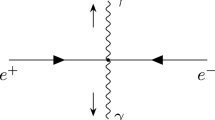Abstract
Issuing from a geometry with nonmetricity and torsion we build up a generalized classical electrodynamics. This geometrically founded theory is coordinate covariant, as well as gauge covariant in the Weyl sense. Photons having arbitrary mass, intrinsic magnetic currents, (magnetic monopoles), and electric currents exist in this framework. The field equations, and the equations of motion of charged (either electrically or magnetically) particles are derived from an action principle. It is shown that the interaction between magnetic monopoles is transmitted by massive photons. On the other hand, the photon is massive only in the presence of magnetic currents. We obtained a static spherically symmetric solution, describing either the Reissner-Nordstrom metric of an electric monopole, or the metric and field of a magnetic monopole. The latter must be massive. In the absence of torsion and in the Einstein gauge one obtains the Einstein-Maxwell theory.
Similar content being viewed by others
REFERENCES
P. A. M. Dirac, Proc. Roy. Soc. London A 133, 60 (1931).
P. A. M. Dirac, Phys. Rev. 74 817 (1948).
J. D. Jackson, Classical Electrodynamics, 2nd edn., (Wiley New York, 1975), p. 254.
M. N. Saha, Ind. J. Phys. 10, 141 (1936).
M. N. Saha, Phys. Rev. 75, 1968 (1949).
H. A. Wilson, Phys. Rev. 75, 309 (1949).
A. S. Goldhaber, Phys. Rev. 140, 1407 (1965).
Y. Aharonov and D. Bohm, Phys. Rev. 115, 485 (1959).
R. W. Kuehne, “A model of magnetic monopoles,” preprint (1996).
L. de Broglie, C. R. Acad. Sc. (Paris) 199, 445 (1934).
R. A. Lyttleton and H. Bondi, Proc. Roy. Soc. London A 252, 313 (1959).
H. Ardavan, Phys. Rev. D 29, 207 (1989).
S. Coleman and E. Weinberg, Phys. Rev. D 7, 1888 (1973).
A. S. Goldhaber and M. N. Nieto, Rev. Mod. Phys. 43, 277 (1971).
Particle Data Group (Review of Particle Properties), Phys. Rev. D 50, 1191, 1351 (1994).
M. Israelit, Gen. Rel. Grav. 29, 1411 (1997).
M. Israelit, Gen. Rel. Grav. 29, 1597 (1997).
H. Weyl, Ann. Phys. (Leipzig ) 59, 101 (1919).
A. Einstein, Ann. Phys. (Leipzig ) 49, 769 (1916).
P. A. M. Dirac, Proc. Roy. Soc. London A 333, 403 (1973).
N. Rosen, Found. Phys. 12, 213 (1982).
M. Israelit and N. Rosen, Found. Phys. 13, 1023 (1983).
M. Israelit, Found. Phys. 19, 33 (1989).
J. Schouten, Ricci Calculus (Springer, Berlin, 1954).
A. L. Proca, J. Phys. Rad. 7, 347 (1936).
L. D. Landau and E. M. Lifshitz, The Classical Theory of Fields (Pergamon, Oxford, 1975).
R. T. Hammond, Nuovo Cimento B 108, 725 (1993).
K. Hayashi and T. Shirafuji, Prog. Theor. Phys. 64, 866 (1980).
R. G. Chambers, Phys. Rev. Lett. 5, 3 (1960).
M. Israelit, Found. Phys. 19, 77 (1989).
W. R. Wood and G. Papini, Phys. Rev. D 45, 3617 (1992).
V. Canuto, P. J. Adams, S.–H. Hsieh, and E. Tsiang, Phys. Rev. D 16, 1643 (1977).
Rights and permissions
About this article
Cite this article
Israelit, M. Torsional Weyl-Dirac Electrodynamics. Foundations of Physics 28, 205–229 (1998). https://doi.org/10.1023/A:1018700819298
Issue Date:
DOI: https://doi.org/10.1023/A:1018700819298




